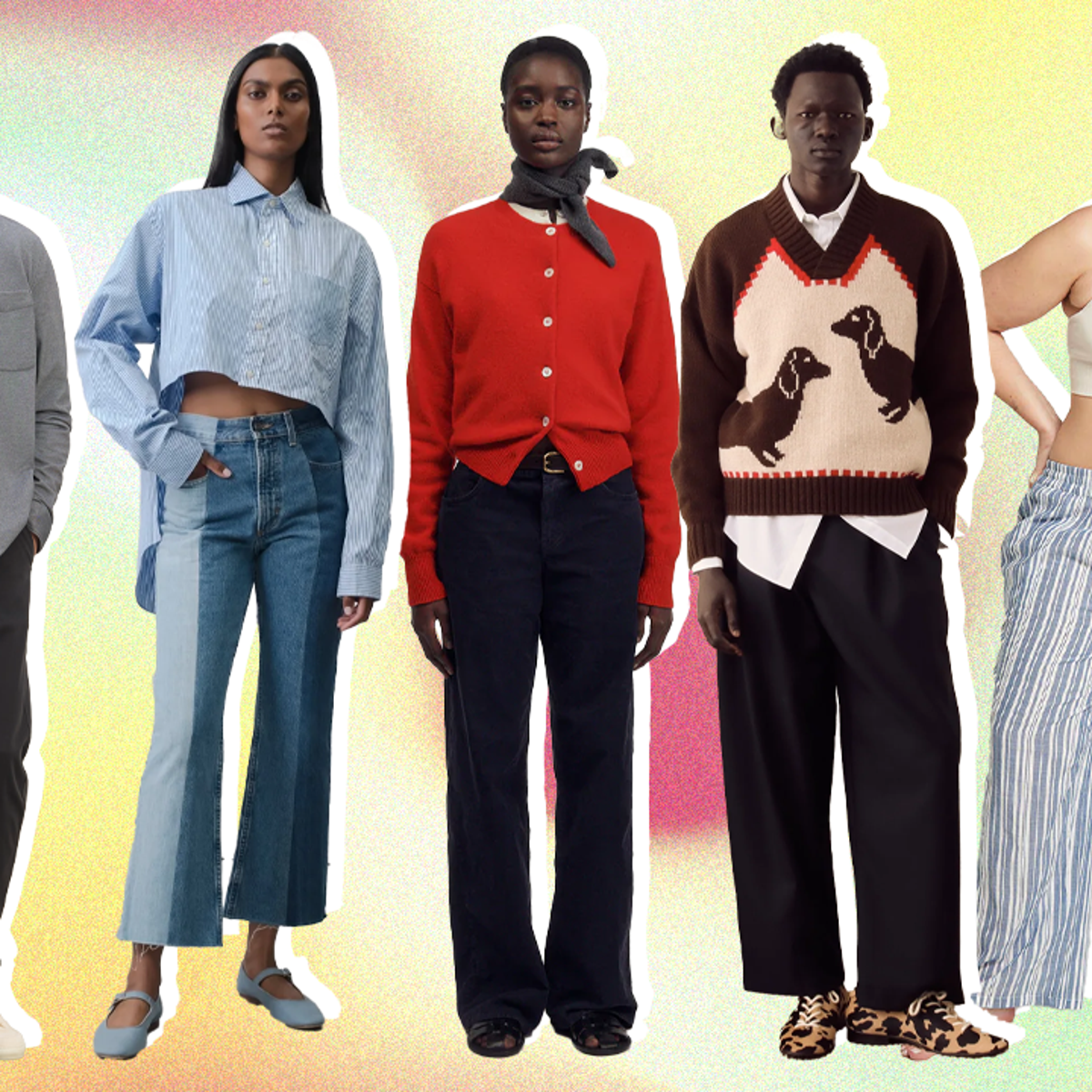A Guide to Choosing Weather-Appropriate Branded Clothing Materials
A Guide to Choosing Weather-Appropriate Branded Clothing Materials
Blog Article
The Importance of Lasting Apparel: How It Affects the Setting and Your Closet
Sustainable apparel is progressively identified for its vital duty in minimizing the environmental influence of the fast garment industry. By concentrating on eco-friendly materials and moral manufacturing methods, it resolves pressing eco-friendly problems. This shift not just profits the planet but additionally affects customer options, leading to a much more thoughtful method to wardrobe monitoring. Comprehending these dynamics increases necessary inquiries concerning fashion's future and individual duty fit it.
The Ecological Impact of Quick Fashion

Advantages of Sustainable Products
Sustainable materials provide significant advantages, specifically with green fabric selections that lessen environmental injury. These materials likewise demonstrate resilience and longevity, decreasing the requirement for constant replacements. Therefore, they add to a more sustainable apparel industry and promote liable consumer actions.
Eco-Friendly Material Options
While the style market has long been related to fast trends and environmental injury, the surge of eco-friendly material choices provides a transformative opportunity. Sustainable materials such as organic cotton, hemp, and Tencel have actually acquired appeal because of their reduced environmental effect. These materials are frequently produced without harmful pesticides and need much less water, minimizing their carbon footprint - Branded Clothing. In addition, several eco-friendly materials are biodegradable, adding to a circular economic situation by minimizing waste. Choosing sustainable products not only supports environmentally accountable practices however likewise promotes much healthier ecosystems. As consumers end up being much more familiar with their buying power, the demand for environment-friendly fabrics motivates brands to introduce and take on more sustainable production methods, inevitably benefiting the world and future generations
Durability and Long Life Benefits
Many customers are progressively acknowledging the longevity and longevity advantages of sustainable products in their clothing choices. Unlike conventional materials, lasting products such as natural cotton, hemp, and recycled polyester are engineered to stand up to damage, causing garments that last much longer. This lowered regularity of replacement not only conserves consumers cash gradually but likewise diminishes waste produced by rapid fashion. In enhancement, lasting clothes usually uses eco-friendly manufacturing approaches that enhance material strength, adding to a decrease in the total carbon footprint. By buying long lasting garments, customers can cultivate a much more sustainable closet while delighting in premium pieces that maintain their aesthetic and capability gradually. As a result, toughness and long life stand as vital advantages of picking lasting products.
Decreasing Waste With Sustainable Practices
Lowering waste in the style sector can be accomplished with ingenious methods such as upcycling and repurposing products. In addition, adopting minimal closet techniques motivates customers to focus on top quality over amount, inevitably reducing apparel usage. Together, these methods add substantially to a more sustainable clothing version.
Upcycling and Repurposing Products
Upcycling and repurposing products have become innovative strategies in the garment industry, transforming discarded textiles right into valuable brand-new products. This method not only minimizes waste yet also encourages creative thinking and uniqueness in apparel design. By taking old garments and materials, designers can create distinct items that mirror personal style while reducing the demand for new sources. In addition, upcycling typically requires less power and water compared to typical production processes, significantly lowering the environmental impact of fashion. As customers come to be a lot more knowledgeable about sustainability, the popularity of upcycled clothing continues to rise, promoting a circular economy. Inevitably, these methods add to an extra lasting future, where style prioritizes ecological health and wellness over rapid manufacturing and consumption.

Minimal Wardrobe Techniques
As people significantly look for to minimize their environmental influence, taking on minimal wardrobe strategies has actually gained traction as an efficient strategy to lasting style. These strategies stress high quality over amount, encouraging consumers to curate a smaller sized collection of versatile, durable clothing. By concentrating on ageless pieces official statement that can be mixed and matched, people can reduce the regularity of purchases and ultimately reduce waste.Additionally, minimalism promotes mindful intake, prompting shoppers to show on the environmental and moral implications of their selections. This strategy not just fosters a much more lasting way of life but also streamlines everyday decision-making regarding clothes. As people accept minimal principles, they add to a fashion society that values sustainability and liable consumerism, eventually causing an extra eco-conscious culture.
The Duty of Ethical Labor in Sustainable Style
While numerous customers are increasingly knowledgeable about the ecological repercussions of their apparel selections, the importance of ethical labor methods in sustainable style can not be forgotten. Moral labor includes reasonable earnings, safe working conditions, and respect for employees' civil liberties, creating the foundation of accountable style production. Brand names that focus on ethical labor not only boost areas yet additionally set a standard for responsibility in the industry.Moreover, the combination of moral methods cultivates transparency, making it possible for customers to make educated options concerning their purchases. This technique contrasts greatly with rapid style's unscrupulous labor designs, which often prioritize earnings over individuals. By sustaining firms committed to moral labor, customers add to a system that values human self-respect together with ecological sustainability. Honest labor is not simply an add-on; it is necessary to the more comprehensive goal of lasting style, ensuring that the mission for eco-friendliness does not come at the expenditure of human rights.
The Effect of Lasting Clothing on Carbon Emissions
Lasting apparel has the possible internet to significantly decrease carbon exhausts connected with the garment industry. Conventional garment production adds especially to greenhouse gas exhausts, primarily due to energy-intensive production procedures and using non-renewable sources. On the other hand, lasting fashion concentrates on eco-friendly products, such as natural cotton or recycled fibers, which typically call for less energy to produce.Moreover, sustainable brands often tend to take on much more efficient production methods, reducing waste and reducing overall exhausts. By prioritizing longevity and timeless design, lasting clothes motivates customers to acquire less often, more lowering the carbon impact connected with overconsumption.Additionally, many sustainable brand names are devoted to transparency in their supply chains, making it possible for consumers to make informed selections that line up with their worths. Ultimately, shifting towards sustainable clothing can lead to a substantial decrease in carbon discharges, contributing to a healthier planet and an extra lasting future for the garment industry.
Sustaining Regional Economic Situations With Lasting Options
The shift towards sustainable apparel not just addresses ecological problems however likewise significantly advantages neighborhood economic climates. By choosing lasting style, customers typically support local artisans and local business, enhancing community resilience. These ventures generally operate a smaller sized scale, focusing on workmanship and moral methods over mass production.Investing in locally made lasting garments fosters job production and stimulates economic growth within areas. As customers end up being extra knowledgeable about the environmental influence of their acquisitions, they progressively look for products that reflect their worths. This need motivates regional manufacturers to embrace lasting practices, adding to a round economy.Moreover, sustaining regional services reduces transport discharges, aligning with eco-conscious consumer habits. The interconnectedness of sustainable clothing and neighborhood economic situations highlights the vital duty that private options play in promoting both environmental and financial health and wellness. By fostering these regional connections, neighborhoods can prosper while additionally functioning in the direction of a more lasting future.
Transforming Your Closet: Tips for a Lasting Closet
As people look for to minimize their environmental impact, transforming a storage room into a lasting wardrobe ends up being a vital step. One efficient approach is to evaluate existing garments, keeping only products that are put on on a regular basis and that line up with sustainability objectives. Prioritizing quality over amount is important; buying durable items from eco-friendly brand names can significantly reduce waste.Additionally, including used items can breathe new life into a wardrobe while minimizing environmental damages. Organizing apparel swaps with buddies or giving away extra products can additionally promote sustainability.When purchasing, people must seek products that are organic, recycled, or biodegradable, and prevent fast style stores - Branded Clothing. Practicing mindful intake useful site by thoughtfully considering each purchase can contribute to a more sustainable lifestyle. By implementing these ideas, one can develop a wardrobe that shows individual design while sustaining ecological stewardship
Regularly Asked Questions
How Can I Recognize Lasting Clothing Brands?
To determine sustainable apparel brands, one ought to investigate materials used, look for qualifications like Fair Profession, and examine the brand name's openness regarding their manufacturing processes, labor practices, and environmental impact, making certain ethical and eco-friendly techniques are focused on.
What Are the Prices Connected With Sustainable Style?
The costs related to lasting fashion can differ considerably. Higher production expenditures, honest sourcing, and environment-friendly materials often cause boosted list prices, which might deter some consumers while appealing to environmentally mindful consumers.
Can Lasting Clothes Be Fashionable and fashionable?
Lasting clothing can indeed be elegant and trendy. Developers progressively prioritize cutting-edge materials and moral manufacturing approaches, verifying that style and sustainability can exist together. Customers now have varied choices that blend aesthetic appeals with environmental awareness.
Exactly How Does Laundering Clothing Affect Their Sustainability?
Cleaning garments substantially effects sustainability by consuming water and energy, adding to air pollution, and creating microplastic launch. Frequent cleaning can break down materials, reducing their life expectancy and increasing the need for replacements, inevitably intensifying ecological worries.
What Is the Lifespan of Lasting Apparel Contrasted to Rapid Style?
The lifespan of lasting clothes generally goes beyond that of rapid fashion products, usually lasting a number of years due to top quality products and craftsmanship. On the other hand, rapid style garments might weaken promptly, demanding more regular substitutes. Sustainable clothes is increasingly recognized for its important duty in minimizing the environmental impact of the quick style market. While several consumers are increasingly aware of the ecological repercussions of their clothes choices, the importance of honest labor techniques in lasting style can not be neglected. Branded Clothing. Sustainable apparel has the possible to considerably minimize carbon discharges connected with the style sector. In contrast, lasting fashion concentrates on environment-friendly products, such as natural cotton or recycled fibers, which usually require much less energy to produce.Moreover, sustainable brand names tend to embrace much more effective production methods, minimizing waste and reducing total emissions. By prioritizing longevity and ageless layout, sustainable apparel encourages customers to purchase much less regularly, additional decreasing the carbon footprint linked with overconsumption.Additionally, lots of sustainable brands are devoted to transparency in their supply chains, enabling consumers to make informed choices that align with their worths
Report this page